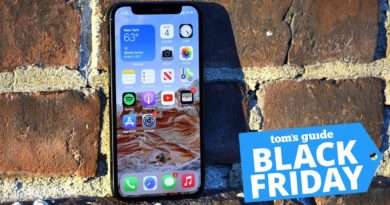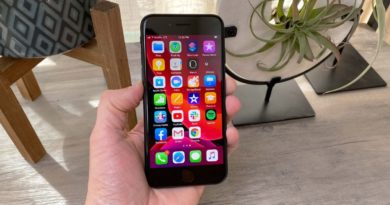iPhone 11 vs. iPhone 11 Pro vs. iPhone 11 Pro Max: Which should you buy?
![]()
Can you tell the three iPhone 11 models apart? Our iPhone 11 vs iPhone 11 Pro vs iPhone 11 Pro breaks down all the key differences so you can decide which one is right for you.
Don’t worry if you haven’t committed to memory the different features and enhancements Apple brought to each iPhone that it introduced a year ago. We’ve tested and reviewed the iPhone 11, iPhone 11 Pro and iPhone 11 Pro Max, continuing to revisit the phones since their September 2019 release. As a result, we can tell you about the similarities and differences between these new phones — not to mention which tops our list of the best iPhones.
And it looks like these iPhones models are going to be around a little bit longer than expected. Apple has confirmed that the iPhone 12 won’t ship in September — typically the month when Apple introduces its new phones. Until the new iPhone arrives — and you can read our iPhone 12 hub to see what changes are expected — here’s how the current iPhone lineup compares.
iPhone 11 vs. iPhone 11 Pro vs. iPhone 11 Pro Max: The specs
| Model | iPhone 11 | iPhone 11 Pro | iPhone 11 Pro Max |
| Starting Price | $699 | $999 | $1,099 |
| Screen Size (Resolution) | 6.1-inch Liquid Retina HD (1792 x 828) | 5.8-inch Super Retina XDR (2436 x 1125) | 6.5-inch Super Retina XDR (2688 x 1242) |
| CPU | A13 Bionic | A13 Bionic | A13 Bionic |
| RAM | Unknown | Unknown | Unknown |
| Storage | 64GB, 256GB, 512GB | 64GB, 256GB, 512GB | 64GB, 256GB, 512GB |
| microSD? | No | No | No |
| Rear Cameras | 12-MP wide (f/1.8), 12-MP ultra wide (f/2.4) | 12-MP wide (f/1.8), 12-MP ultra wide (f/2.4), 12-MP telephoto (f/2.0) | 12-MP wide (f/1.8), 12-MP ultra wide (f/2.4), 12-MP telephoto (f/2.0) |
| Front Camera | 12-MP (f/2.2) | 12-MP (f/2.2) | 12-MP (f/2.2) |
| Battery Life (Hrs:Mins) | 11:16 | 10:24 | 11:54 |
| Water Resistance Rating | IP68 (2 meters up to 30 minutes) | IP68 (4 meters up to 30 minutes) | IP68 (4 meters up to 30 minutes) |
| Size | 5.9 x 3 x 0.33 inches | 5.7 x 2.8 x 0.32 inches | 6.2 x 3.1 x 0.32 inches |
| Weight | 6.84 ounces | 6.63 ounces | 7.97 ounces |
| Colors | Black, Green, Yellow, Purple, White, Product RED | Gold, Space Gray, Silver, Midnight Green | Gold, Space Gray, Silver, Midnight Green |
iPhone 11 vs. iPhone 11 Pros: Prices compared
Back in 2018, the iPhone XR introduced a price gap between Apple’s entry-level smartphone and its more feature-rich models, and that gap only widened with the iPhone 11 family’s debut. Thanks to the iPhone 11’s starting price of $699, there’s now a $300 gap between it and the base model iPhone 11 Pro, which starts at $999. Even the most expensive iPhone 11 model — one that comes with 512GB of storage— costs $150 less than the cheapest iPhone Pro model.
To encourage existing iPhone users to upgrade to the new models, Apple offers rebates if you trade-in your current phone. At the beginning of August 2020, you can expect to save up to $220 on the iPhone 11 and $280 on the iPhone 11 Pro models, though you’ll need a pretty recent phone to see that kind of return. Nevertheless, trading in your phone when you buy a new iPhone from Apple can save you a little bit of cash.
The iPhone is widely available from wireless carriers, too — and not just the big ones like AT&T, T-Mobile and Verizon. You’ll also find iPhone 11 models through discount carriers and wireless services tied to cable operators, such as Xfinity. Different wireless carriers routinely offer deals for the latest iPhones, though don’t expect too much of a discount on the new models. Usually, you see BOGO offers that dangle a second iPhone or rebates if you trade in a newer phone. Be sure to check out the best iPhone 11 deals to make sure you’re getting the best price before you buy.
Of course, if you’re looking for cheap iPhones, you can always turn to the iPhone XR, which remains available from Apple at $599. This spring, the company introduced a new iPhone SE, though at 4.7 inches this model is slightly bigger than the original SE. Still, the iPhone SE 2020 is powered by the same A13 Bionic process found in the iPhone 11 models.
If you can hold out until the iPhone 12’s release, the iPhone 11 may be due for a big price drop. A rumor suggests Apple will keep the iPhone 11 around after the iPhone 12’s debut, cutting the price of the phone by $150 to $549. Apple generally keeps at least one current model in its lineup after introducing new phones, so this rumor squares with how the company typically does things.
iPhone 11 vs. iPhone 11 Pros: Design and size
You definitely won’t confuse the iPhone 11 with its Pro counterparts. The iPhone 11 features an aluminum and glass body and comes in a rainbow of colors — purple and green are the newcomers, joining the black, yellow, white and red variants that are held over from the iPhone XR.
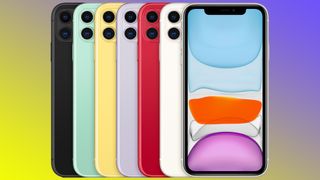
The iPhone 11 Pro and iPhone 11 Pro Max opt for a more sophisticated look. These phones use stainless steel for their frame, and the glass has a matte finish to it. Your color options are more staid here, though Apple does include a Midnight Green version alongside more traditional choices like Space Gray, Silver and Gold.
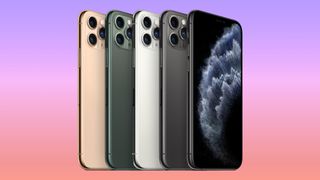
Apple emphasized the durability of the iPhone 11 Pro and 11 Pro Max when it introduced those phones last year. All three new iPhones boast IP68 dust- and water-resistance ratings, though not all IP68 ratings are apparently created equal. The iPhone 11 can survive a 30-minute dunk in up to 2 meters of water, while the Pro models can go a bit deeper to 4 meters.
No matter which model you pick up, you’re going to get a noticeable camera bump. It’s precision milled to fit in with the rest of the phone, whether you’ve got an iPhone 11 or one of the Pro models in your hand.
The same dimensions you saw with the iPhone XS, XS Max and XR are back with the current models. The iPhone 11 Pro Max is the tallest and widest of Apple’s new phones, and it weighs the most. The next tallest phone, the iPhone 11 is also the thickest, though only by a fraction of an inch. The iPhone 11 Pro is the most compact model. As with recent iPhones, there’s no headphone jack to be found on any of member of the iPhone 11 family.
iPhone 11 vs. iPhone 11 Pros: Displays
It’s once again a tale of two displays for Apple’s different smartphones. Like the iPhone XR before it, the iPhone 11 makes do with an LCD panel, while the iPhone 11 Pro and 11 Pro Max feature an OLED screen. While little seems to have changed on paper about the iPhone 11’s 6.1-inch Liquid Retina, it turns out to be brighter than the one on the iPhone XR (652 nits vs. 589 nits). The iPhone 11 registered 113% of the sRGB color gamut, which is nothing close to what you get with an OLED panel, though the iPhone 11’s colors are very accurate. (That Delta-E rating of 0.22 is pretty close to a perfect score of zero on that test.)
When you look at the Super Retina XDR display that graces the iPhone 11 Pro and 11 Pro Max, though, you’ll get a sense of why these models cost more. Both phones are super bright — the iPhone 11 Pro hit 752 nits on our light meter, while the 11 Pro Max topped 761. These are the phones you’re going to want to take outside.
The colors on the Super Retina XDR display aren’t as vibrant as what you’ll get from some OLED panels, though that’s a deliberate choice Apple makes in tuning its displays to be less saturated. The colors are accurate, though, with the iPhone 11 Pro Max recording a Delta-E score of 0.28.
One thing we’ve noticed with all three phones now that we’ve tested them — the spatial audio feature really makes a difference when you’re watching videos. The wider sound stage, along with Dolby Atmos support, puts audio all around you, creating a more immersive experience.
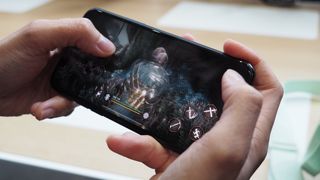
The iPhone 11 models feature the same screen sizes we saw on the 2018 phones. The iPhone 11 uses a 6.1-inch panel, which is smack dab in the middle of the iPhone 11 Pro’s 5.8-inch display and the 6.5-inch screen on the iPhone 11 Pro Max. Like the Liquid Retina display on the iPhone 11, the Pro series screens feature Haptic Touch, instead of 3D Touch.
iPhone 11 vs. iPhone 11 Pros: Cameras
This probably stands out as the big differentiator between the new iPhone models. The iPhone 11 features two rear cameras — a 12-megapixel wide angle lens with an f/1.8 aperture and a 12-MP ultra wide lens with an f/2.4 aperture. That ultra wide lens delivers a 120-degree field of view so that you can capture more of your surroundings in images when you zoom out.
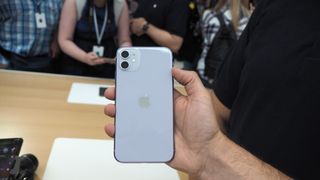
Those two cameras return on the iPhone 11 Pro and 11 Pro Max, but they’re joined by a third 12-MP lens. This telephoto lens features an f/2.0 aperture, letting in 40% more light than the telephoto lens Apple included on last year’s iPhone XS. You get a 2x optical zoom from the telephoto lens.
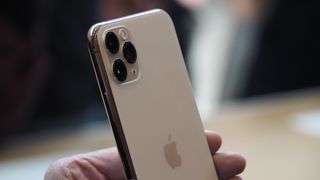
Despite the extra lens on the Pro models, the three phones support many of the same camera features. Whether you have an iPhone 11 or one of the Pro models, a new Night Mode should mean better pictures in low light. All three new phones offer QuickTake, a new camera function where you can capture video while also shooting still images just by long-pressing on the shutter. Even the upcoming Deep Fusion feature, which combines nine different shots for a more detailed image, will work on the iPhone 11 just as it does on the iPhone 11 Pro.
All three phones also sport the same 12-MP front camera and offer the ability to take slow-motion videos — a feature that Apple has dubbed “slofies” to the rest of the world’s apparent amusement. Those front cameras can also shoot 4K video at 60 fps, too.
All three iPhones fared impressively in our testing, which included comparing their output to images shot by leading camera phones from Google and Samsung. (We’ve got a full comparison between the iPhone 11 Pro and Pixel 4.) The Night Mode feature is particularly welcome, letting Apple’s new phones produce dramatically better shots in low light. In fact, the iPhone 11 Pro is our pick for the best camera phone.
Still, on most shots, you’d be hard-pressed to tell the difference on what was captured by an iPhone 11 versus one of Apple’s 11 Pro models. The big exception is portrait shots, since the iPhone 11 Pro and iPhone 11 Pro Max have the benefit of a telephoto lens for focusing on subjects. And if you really want to see the advances Apple has made with its cameras in recent years, check out our iPhone 11 vs. iPhone 8 face-off.
iPhone 11 vs. iPhone 11 Pros: Performance
On paper, there’s little to separate the iPhone 11 from the Pro models, as all three are powered by Apple’s A13 Bionic processor. And since the A12 Bionic from 2018’s phones already outperformed more recently released Android flagships, you’d be correct that the gap widens further with this new chip, though the Snapdragon 865 and Snapdragon 865 Plus powering the year’s top Android phones have pulled some models closer to the iPhone 11.
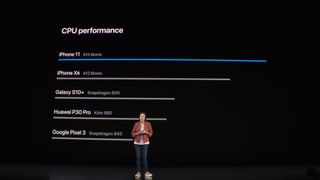
When introducing the iPhone 11 Pro, Apple told us to expect 20% performance improvements from the CPU, GPU and neural processor contained within the A13. And the newer chip is more energy efficient, too, with Apple touting a 40% improvement in power consumption just for the A13’s GPU.
In terms of benchmark results, the iPhone 11 Pro Max and iPhone 11 Pro turned in comparable results on Geekbench 5, which measures overall performance (3,517 and 3,509, respectively.) The iPhone 11 was slightly behind with a multicore score of 3,251 — a surprising difference given that all three iPhone 11 models have the same 4GB of RAM according to phone teardowns. Suffice it to say, even the iPhone 11 beat out the Geekbench 5 score of the Galaxy S20 (3,147); the OnePlus 8 Pro topped the iPhone 11 with a multicore score of 3,379, though the iPhone 11’s single-core result still tops the latest OnePlus phone.
iPhone 11 vs. iPhone 11 Pros: Battery Life
The iPhone XR and XS releases introduced us to an upside-down world where Apple’s least expensive model, the iPhone XR, also had the longest-lasting battery. Apple says the XR was the longest lasting iPhone it ever built, and the company wasn’t kidding — it turned in a time of 11 hours, 26 minutes on our battery test, which was nearly an hour better than the iPhone XS Max’s result.
Order has been restored to the universe with the iPhone 11 lineup. Now, the iPhone 11 Pro Max takes the long-lasting iPhone crown by lasting an average of 11 hours and 54 minutes while continuously surfing the web over LTE. The iPhone 11 also turned in a good result of 11:16, though that’s a few minutes behind the XR’s result from a year ago. Both those iPhones landed on our list of the best phone battery life we’ve seen on devices tested in the last 18 months.
The iPhone 11 Pro improved upon the below-average result of the iPhone XS, though at 10:24, its result was still roughly an hour behind the regular iPhone 11.
The iPhone 11 Pro and 11 Pro Max charge faster out of the box. Those models ship with an 18-watt charger. On the iPhone 11 Max, we got the battery up to 55% after 30 minutes of charging — good, though the Note 10 Plus and OnePlus 7 charge faster. The iPhone 11 supports faster charging, too, though you’ll have to buy your own 18-watt adapter.
Which iPhone 11 should you buy?
Having tested all three new iPhones, it’s clear that the iPhone 11 Pro Max is the best iPhone you can buy and one of the best phones overall, thanks to its expansive screen and long battery life. But not everyone is going to want to pay $1,099 for those kinds of features.
Good thing, then, that the iPhone 11 is $400 cheaper and offers comparable performance and good battery life of its own. As for the iPhone 11 Pro, it’s a good model to get if you like your phones a little more compact.
Even with a delayed launch Apple will release new iPhones in the fall, raising the question of whether it’s better to hold off until the expected October launch for the iPhone 12. If you can afford to wait, the iPhone 12 is likely to come in four different models with faster processors and OLED panels all around. Those phones will also support 5G connectivity, something missing from the iPhone 11 lineup.
If you must get an iPhone prior to October, though, deciding between the iPhone 11 vs the iPhone 11 Pro vs the iPhone 11 Pro Max is a can’t lose proposition. All three of Apple’s current iPhone models are top phones.
